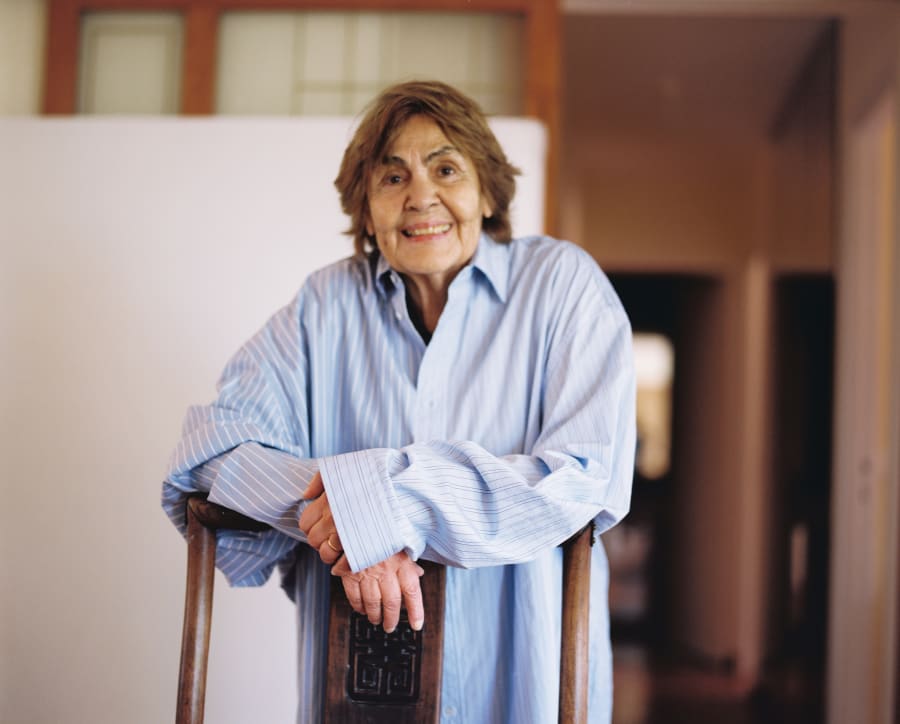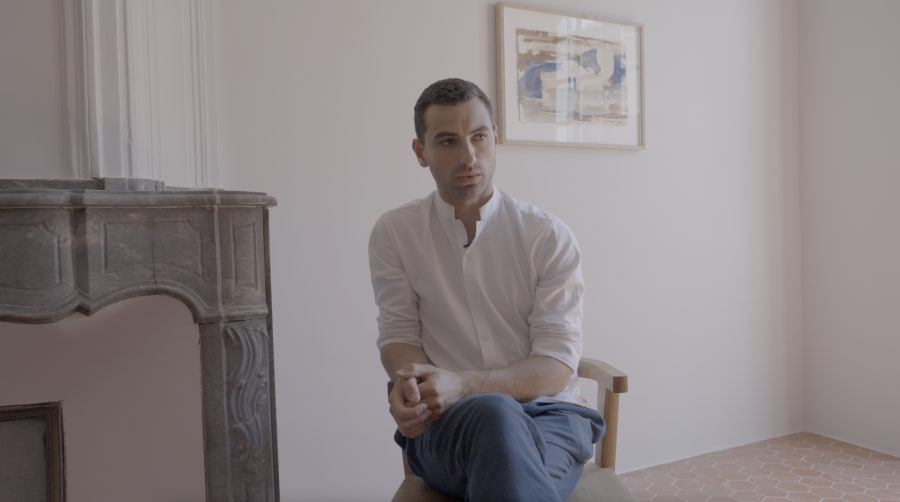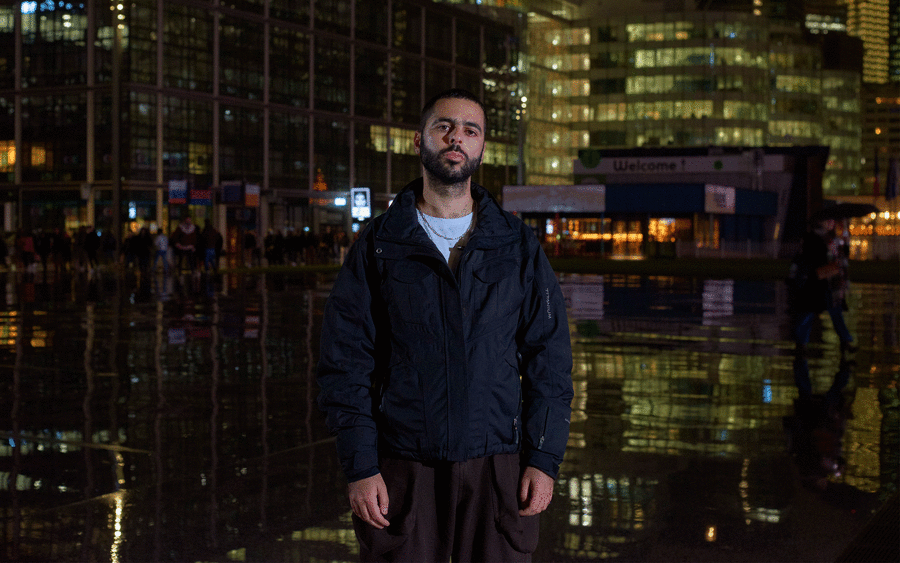From sculptures of swollen biceps to paintings of twirling gymnasts, depicting the body’s physicality has seduced artists for the longest of times. Take Discobolus, the grand statue of a disc-thrower by the Greek sculptor Myron, made in the fifth century BC. Each element – from the figure’s raised back arm to his twisted torso – is an expression of pure athleticism. Art like this, of the so-called ideal physical form, rippled through the classical period and has influenced art made in the two millennia since.
Thankfully, our definitions of an athletic body have expanded, and so too have our critical responses to art depicting them. Across mediums and continents, contemporary artists continue to find new ways of expressing movement and sport, which, with the 2024 Paris Olympics around the corner, feel all the more resonant today.
在這位德國藝術家於紐約貝浩登(Perrotin)舉辦的首次個展「When the Sun Hits the Moon」中,有幾幅畫作是初次亮相,主題為安東尼奧.卡諾瓦(Antonio Canova)的新古典主義雕塑中描繪的愛神厄洛斯與普姬幾乎接吻的場景。愛神不允許他的世間愛人看到他在光明中的樣子;當普姬拿著蠟燭對著愛神面龐的那一刻,這對戀人就永久地斷開了聯繫。Greven說:「我喜歡這個意象,因為我捕捉到的那一刻,他們還在互相對視,但未真正看見對方的面貌。他們仍處於黑暗之中,以內心注視和以內在擁抱。」
Some of the most compelling contemporary renderings of sport include the non-organized, non-traditional variety. We’re Up Next, a 2023 painted paper collage by Melvin Nesbitt Jr., depicts a pick-up basketball game in a public housing community like the one Nesbitt grew up in. The artist has said he seeks to capture the joy of Black childhood, and his scenes of kids playing, dancing, and throwing around a ball do just that. In slightly more adult scenarios, Puerto Rican artist Jean-Pierre Villafañe (who has a solo show at Charles Moffett, New York, through August 2) similarly finds joy in his ecstatic paintings of libertine figures. His 2023 painting Permanent Vacation depicts five beachgoers in various states of undress, tapping a beach ball, carrying a tray of cocktails, and otherwise posing with their long, toned legs extended. Villafañe’s work, whether set in an office, a dance hall, or the great outdoors, gets at a different kind of physical effort beyond the bright lights of an arena.
Bodies do not have to bear flesh to indicate movement. South African artist Sthenjwa Luthuli creates hand-carved wooden reliefs of lithe figures suspended in what he calls ‘unknown space.’ Those bodies are covered in all-over patterns, which Luthuli paints on top of his carved wood boards. The effect is mesmerizing. They feel very much alive and in motion, almost like gymnasts: leg muscles taut, feet arched, and arms stretched out in elegant yearning. These figures, almost classical in their sculpted physiques, remind us that even when coming from disparate parts of the world, human bodies are really not so different across time and space.
There are team sports, individual sports, and the nebulous world of the mano a mano competition, which asks: Are they fighting or are they embracing? Works by French artist Claire Tabouret from her 2018 show at Almine Rech, such as Muddy River and The Grip, capture this kind of intimacy. In her scenes of conflict, a pair of figures variously wrestle and collapse into what could be taken for a hug. Tabouret has long been praised for her portraiture, and these works, too, engage in a kind of dreamy dichotomy that mirrors our own inner conflicts. The softness with which she depicts physical engagement holds the viewer’s attention until they feel part of their world.
Of course, there is a dark side to athletics, and there is perhaps no contemporary artist critiquing professional sports as Matthew Barney has. In much of Barney’s performance and installation work, physical effort is front and center, often deployed as commentary on machismo culture. His early ‘Drawing Restraint’ series, which he began in 1987 while an art student at Yale, were inspired by resistance training. But his most iconic contribution to art about sports is Secondary (2023), a five-channel video installation made in response to the 1978 football game that left Darryl Stingley, a wide receiver for the New England Patriots, paralyzed after a hit from Jack Tatum, a defensive back for the Oakland Raiders. (Secondary is on view this summer at Fondation Cartier pour l’art contemporain in Paris, through September 8.) When the incident happened, Barney himself was a high school football player. The violence, risk, and life-changing consequences of that one game – and its infinite replays on television – left a lasting mark on the American artist.
What is the goal of engaging in sport? In Raymond Pettibon’s surfing paintings, begun in the 1980s, the artist makes a pretty good case for the pursuit of something grander than oneself. With tiny figures balancing on their boards as a colossus of water rises above, Pettibon sets a scene of transcendence – or at least of yearning for it. His surfers are not vanquished by nature, tumbled over into the sea. They are flecks of fortitude and resilience, seeing what their bodies can do in the face of great physical challenge. Even for the non-surfers among us, these sparse but vivid works make you want to head to the nearest beach and give it a whirl. They are timeless emblems of chasing the sublime: a quest that unites many artists and athletes.
Grace Edquist is an art writer and the copy director of Vogue magazine. She lives in New York City.
Caption for top image: Melvin Nesbitt Jr., Throwing Down (detail), 2023. Private collection. Courtesy of artist and Richard Beavers Gallery.
Published on July 18, 2024.


